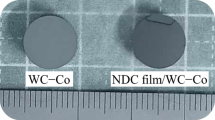Abstract
Electrochemical additive manufacturing (ECAM) is a novel non-thermal metal additive manufacturing technology. The layer height is an important parameter in additive manufacturing processes which determines the resolution and quality of the parts manufactured. The modeling of the rate of deposition enables the prediction of the layer size and time of deposition for a particular feature. The developed model takes the electrical process parameters and the horizontal scan speed as inputs and gives the rate of deposition and deposited layer height as the output. The current density was calculated based on an existing model considering ion transport and electrode kinetics. The predicted deposition rates were validated with experimental findings. It was found that the pulsed voltage with a 75% duty cycle had the highest deposition rate. While the deposition rates varied between 1 and 3 μm/s, the scan speed was found to be between 0.1 to 2 mm/s for a diameter 250-μm tool. The scan speed had a lower limit for each interelectrode gap below which a possibility of short-circuiting exists. The influence of the pulse duty cycle on the layer height reduces at larger interelectrode gaps.
Similar content being viewed by others
References
Vaezi M, Seitz H, Yang S (2012) A review on 3D micro-additive manufacturing technologies. Int J Adv Manuf Technol 67:1721–1754
Stansbury J, Idacavage M (2016) 3D printing with polymers: challenges among expanding options and opportunities. Dent Mater 32:54–64
Shapiro A, Borgonia J, Chen Q, Dillon R, McEnerney B, Polit-Casillas R, Soloway L (2016) Additive manufacturing for aerospace flight applications. J Spacecr Rocket 53:952–959
MacDonald E, Wicker R (2016) Multiprocess 3D printing for increasing component functionality. Science 353:aaf2093
Chabok H, Zhou C, Chen Y, Eskandarinazhad A, Zhou Q, Shung K (2012) Ultrasound Transducer Array Fabrication Based on Additive Manufacturing of Piezocomposites. ASME. International Symposium on Flexible Automation, ASME/ISCIE 2012 International Symposium on Flexible Automation pp. 433–444. https://doi.org/10.1115/ISFA2012-7119
Kruth JP, Froyen L, Van Vaerenbergh J, Mercelis P, Rombouts M, Lauwers B (2004) Selective laser melting of iron-based powder. J Mater Process Technol 149:616–622
Roberts IA, Wang CJ, Esterlein R, Stanford M, Mynors DJ (2009) A three-dimensional finite element analysis of the temperature field during laser melting of metal powders in additive layer manufacturing. Int J Mach Tools Manuf 49:916–923
Cabrini M, Lorenzi S, Pastore T, Pellegrini S, Ambrosio P, Calignano F, Manfredi D, Pavese M, Fino P (2016) Effect of heat treatment on corrosion resistance of DMLS AlSi10Mg alloy. Electrochim Acta 206:346–355
Sundaram MM, Kamaraj AB, Kumar VS (2015) Mask-less electrochemical additive manufacturing: a feasibility study. J Manuf Sci Eng 137:021006–021015
Brant A, Sundaram M (2016) A novel electrochemical micro additive manufacturing method of overhanging metal parts without reliance on support structures. Proc Manuf 5:928–943
Shailendar S, Sundaram M (2016) A feasibility study of localized electrochemical deposition using liquid marbles. Mater Manuf Process 31:81–86
Brant AM, Sundaram MM, Kamaraj AB (2015) Finite element simulation of localized electrochemical deposition for maskless electrochemical additive manufacturing. J Manuf Sci Eng 137:011018–011018
Madden JD, Hunter IW (1996) Three-dimensional microfabrication by localized electrochemical deposition. J Microelectromech Syst 5:24–32
Yeo S, Choo JH, Yip KS (2000) Localized electrochemical deposition: the growth behavior of nickel microcolumns. In Micromachining and Microfabrication Process Technology VI. International Society for Optics and Photonics. 4174:30–40.https://doi.org/10.1117/12.396421
Wang F, Sun J, Liu D, Wang Y, Zhu W (2017) Effect of voltage and gap on micro-nickel-column growth patterns in localized electrochemical deposition. J Electrochem Soc 164:D297–D301
Said RA (2004) Adaptive tip-withdrawal control for reliable microfabrication by localized electrodeposition. J Microelectromech Syst 13:822–832
Yeo SH, Choo JH (2001) Effects of rotor electrode in the fabrication of high aspect ratio microstructures by localized electrochemical deposition. J Micromech Microeng 11:435–442
Daryadel S, Behroozfar A, Morsali SR, Moreno S, Baniasadi M, Bykova J, Bernal RA, Minary-Jolandan M (2018) Localized pulsed electrodeposition process for three-dimensional printing of Nanotwinned metallic nanostructures. Nano Lett 18:208–214
Kamaraj AB, Sundaram M (2018) A study on the effect of inter-electrode gap and pulse voltage on current density in electrochemical additive manufacturing. J Appl Electrochem 48:463–469
Said RA (2003) Microfabrication by localized electrochemical deposition: experimental investigation and theoretical modelling. Nanotechnology 14:523–531
Kamaraj A, Lewis S, Sundaram M (2016) Numerical study of localized electrochemical deposition for micro electrochemical additive manufacturing. Procedia CIRP 42:788–792
Said RA (2003) Shape formation of microstructures fabricated by localized electrochemical deposition. J Electrochem Soc 150:C549–C557
Wang F, Wang F, He H (2016) Parametric electrochemical deposition of controllable morphology of copper micro-columns. J Electrochem Soc 163:E322–E327
Volgin VM, Kabanova TB, Davydov AD (2018) Modeling of local maskless electrochemical deposition of metal microcolumns. Chem Eng Sci 183:123–135
Volgin VM, Lyubimov VV, Gnidina IV, Davydov AD, Kabanova TB (2018) Simulation of localized electrodeposition of microwires and microtubes. Procedia CIRP 68:242–247
Wang F, Bian H, Wang F, Sun J, Zhu W (2017) Fabrication of micro copper walls by localized electrochemical deposition through the layer by layer movement of a micro anode. J Electrochem Soc 164:D758–D763
Cui CQ, Lee JY (1994) Effects of oxygen reduction on nickel deposition from unbuffered aqueous solutions: I. Deposition Process Deposit Struct J Electrochem Soc 141:2030–2035
Ibrahim MAM (2006) Black nickel electrodeposition from a modified Watts bath. J Appl Electrochem 36:295–301
Popov K, Keča D, Vidojković S, Lazarević B, Milojković V (1976) Mathematical model and digital simulation of pulsating overpotential copper electrodeposition. J Appl Electrochem 6:365–370
Abdel-Hamid Z (1998) Improving the throwing power of nickel electroplating baths. Mater Chem Phys 53:235–238
Wesley WA, Carey JW (1939) The electrodeposition of nickel from nickel chloride solutions. Trans Electrochem Soc 75:209–236
Funding
This material is based upon work supported by the National Science Foundation under Grant Nos. CMMI-1400800 and CMMI-1454181.
Author information
Authors and Affiliations
Corresponding author
Additional information
Publisher’s note
Springer Nature remains neutral with regard to jurisdictional claims in published maps and institutional affiliations.
Rights and permissions
About this article
Cite this article
Kamaraj, A.B., Sundaram, M. A mathematical model of the deposition rate and layer height during electrochemical additive manufacturing. Int J Adv Manuf Technol 102, 2367–2374 (2019). https://doi.org/10.1007/s00170-019-03292-2
Received:
Accepted:
Published:
Issue Date:
DOI: https://doi.org/10.1007/s00170-019-03292-2




